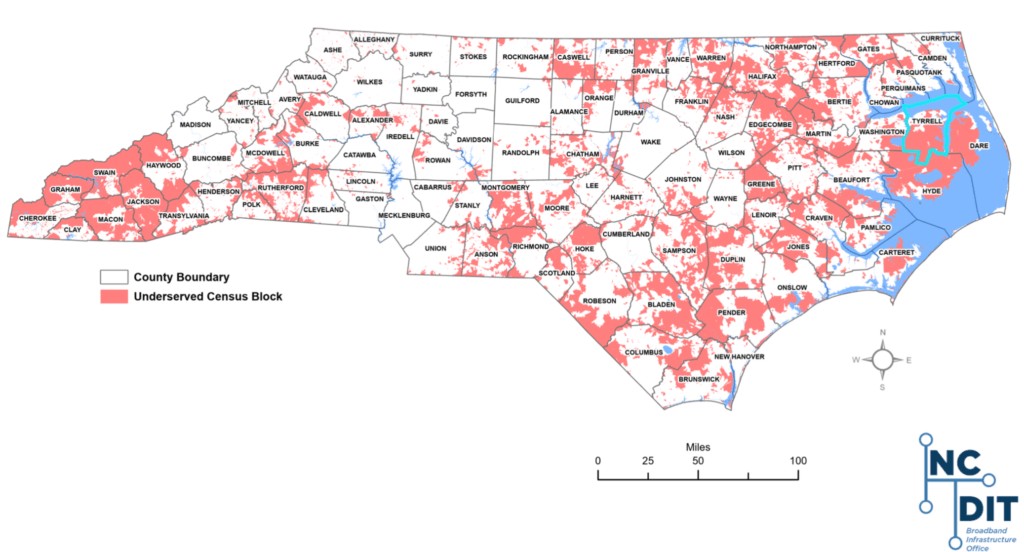Welcome to our monthly feature on EducationNC called the NC STEM ScoreCard, written in partnership with the NC Science, Mathematics, and Technology Education Center (SMT) and the Burroughs Wellcome Fund. The previous edition of the STEM ScoreCard featuring MCNC can be found here.
The goal of the NC STEM ScoreCard is to build broader awareness of how P-20 STEM education is being nurtured across North Carolina and the impact on the well-being of our citizens and state. STEM used here is an acronym for Strategies That Engage Minds.
Strategic Investment in specific programs that increase the quality and impact of STEM education in North Carolina is a central focus of the NC STEM ScoreCard. One of those investments, so essential for STEM education, is in assuring high speed broadband access to students, educators, parents, schools, public libraries and higher education; thus, this month’s focus is on the NC Department of Information Technology Broadband Infrastructure Office.
What is broadband and why is it important?
Another term used for bandwidth — or the amount of data that can be sent through a connection — to access high-speed internet. The more bandwidth, the more information a user can send or receive at any given time.
Broadband allows citizens more affordable and efficient access to basic amenities such as education, healthcare, public safety, and government services by:
- Affording citizens the opportunity to participate in online learning and distance education;
- Giving entrepreneurs and small and home-based business owners the opportunity to compete alongside large corporations;
- Increasing the productivity and efficiency of businesses who utilize the internet for their operations;
- Connecting patients in remote areas to health care services;
- Making government services more readily available to citizens;
- Saving companies and organizations money by letting employees telework; and
- Allowing friends and families to stay in touch with one another.
Why does speed of broadband matter?
Broadband speed is important because it allows for faster transmission (uploading and downloading) of data. Data is transmitted digitally, therefore text, images, and sound are all translated into “bits” of data.
The Federal Communications Commission (FCC) defines basic broadband as transmission speeds of at least 25 megabits per second (Mbps), or 25,000,000 bits per second downstream (from the internet to the user’s computer) and 3 megabits per second upstream (from the user’s computer to the internet).
In January 2015, the FCC updated the recommended “availability” target speed threshold to 25 Mbps (download)/3Mbps (upload) from the previous recommended benchmark 4 Mbps (download)/1 Mbps (upload). Slower speeds, such as dial-up, run at 56 kilobits per second and cannot transmit data as quickly.
Broadband is accessed through various high-speed transmission technologies, which allows these bits to move faster.
How is broadband accessed?
Broadband is accessed through a number of technologies including:
- Digital Subscriber Line (DSL)
- Cable Modem
- Fiber-Optic Cable (Fiber)
- Wireless
- Satellite
- Broadband over Powerline (BPL)
For more information about broadband technologies, go here.
Current status for North Carolina
The FCC reports that 93% of North Carolina’s population has access to the internet at the FCC threshold speeds of 25 Mbps. Of those without access — nearly 640,000 people — live in sparsely populated areas.
Percentage of population without broadband access by county
North Carolina’s broadband deployment rate ranks ninth in the nation, slightly above the U.S. average. Among southeastern states, it ranks first, tied with Florida.
Southeast state broadband infrastructure comparison
Broadband availability at 25 MBPS download speeds in 2016
As the map below shows, significant gaps exist in the state. Not surprisingly, these areas represent some of the state’s most economically distressed regions. Counties struggling with economic development, high unemployment, and aging populations correlate strongly with those with insufficient broadband infrastructure.
Underserved broadband population in 2019

The issue is not strictly a rural one. It also persists where the population density or income levels are low, even in urban areas. Interestingly, there are many sparsely populated counties and areas in the state where residents in small towns and cities have access to next-generation, fast internet service at affordable, or competitive prices.
Broadband adoption of high speed internet
- As of December 2014, only 16% of North Carolinians adopted broadband in their homes compared to the national average of 37% at the recommended speed threshold (25 Mbps download/3 Mbps upload).
- At this adoption rate, North Carolina ranked 40th out of the 45 reporting states.
Broadband Adoption: 2015 Broadband adoption rates at all speeds
Broadband Adoption Rate: 2016 North Carolina v. United States
Individuals with lower levels of education, income, and who are elderly or disabled are less likely to adopt broadband. Research demonstrates that disparities by education and income are consistently larger than those observed by any other factor, including population density.
The 2013 Citizens Survey found that individuals with a graduate degree (97%) and who made ≥ $100,000 per year (99%) were more than twice as likely to adopt broadband than those with less than a high school degree (40%) and who made ≤ $15,000 per year (47%).
This suggests that even in areas where broadband is readily available individuals with lower levels of education and income are by circumstance choosing not to purchase internet services.
K-12 education and technology access: A national perspective
Broadband networks enhance educational experiences by providing students and teachers with access to an array of resources including text-based materials, photos, videos, music, animations, interactive lessons, and oral history collections. It also opens the walls of classrooms, allowing students to participate in distance learning opportunities anytime from any location they can access the internet, such as a library, school or home. Access to these resources is becoming increasing essential for schools, teachers, and students.
Two of the biggest hurdles to moving America’s schools online have been an inadequate number of digital devices for students and millions of families’ lack of high-speed internet at home. These gaps in basic technology access are particularly stark along socioeconomic lines.
In districts with the lowest percentages of students from low-income families, just 1 in 5 leaders reported in late March of 2020 that a lack of basic technology is a “major” problem, compared with nearly two-thirds of leaders in districts where the highest percentages of students are from low-income families.
What is the homework gap?
- The homework gap occurs when students are assigned homework requiring access to the internet but don’t have home access.
- Nationally, 70% of teachers assign homework that requires broadband access, but only 33% of students have access at home.
Greater than 50% of teachers report that limited access to online resources at home presents a major challenge to integrating technology into the classroom. Low-income homes with school-age children are four times more likely to lack broadband than middle or high-income families.
Nationally, seven in 10 teachers assign homework that requires internet access, but an estimated 5 million households with school-age children do not have internet access at home, according to research from the Pew Research Center in 2015.
From difficulty in completing homework to diminished educational outcomes, the consequences of the homework gap are vast and hinder future career and economic opportunities for both the students and their communities.
The need for granular data, coupled with the desire to address the homework gap holistically and systemically led the BIO and The FIRE Group to partner to conduct a pilot research study on the topic. The two organizations designed and piloted a survey to collect information on the homework gap, who it affects, and its primary causes for North Carolina households. This was at the core of a comprehensive study and report generated by The Friday Institute, find the report here.
The homework gap report discusses many of these barriers and policy recommendations. You can learn more about those recommendation here.
The Connecting North Carolina State Broadband Plan also includes policy recommendations that are intended to reduce barriers as well. You can learn more about those recommendations here.
While data on North Carolina’s homework gap has some limitations, several data sets inform where the state sees the largest divide. The figure below shows the areas of the state with the highest percentages of students participating in the free and reduced lunch program overlaid with broadband adoption data.
Want to know more about internet speed in your immediate community and elsewhere? Go to the FCC site here.
Contact information
Broadband Infrastructure Office
NC Department of Information Technology
301 N. Wilmington St., Raleigh, NC 27601
Email: Broadband@NC.Gov
919-754-6695
Questions for maximizing this strategic investment in STEM teacher quality in North Carolina
1.What more needs to be done to maximize on the 2016 NC Broadband Plan to assure access for all students?
2. What additional policies could be enacted by the state to reduce or eliminate racial and income barriers to broadband access?
3. Are measures of the “homework gap” being used to increase connectivity and access in low-wealth schools and communities? What more needs to be done to critical infrastructure inequities in North Carolina?
A special thanks to Wes King, Director of Communications, Broadband Infrastructure Office, and North Carolina Department of Information Technology, for his invaluable assistance in constructing this report
Send questions and comments on the NC STEM ScoreCard to coble@tpanalytics.com
Recommended reading


